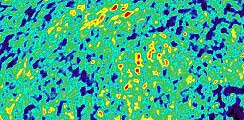What the WMAP!
Cosmology is one of the great success stories of contemporary physics. A few investigators began theorizing about the history of the universe in the 1940s, but there was precious little observational evidence to work with. The one big experimental fact was that the distant galaxies are receding, as inferred from Doppler shifts in their spectral lines. Because there was so little opportunity to test theories against experimental evidence, cosmology was considered by many physicists to be too speculative to be taken seriously.
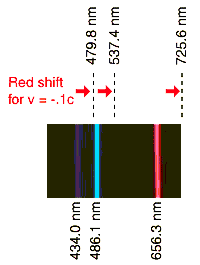
Three atomic spectral lines of hydrogen, as measured in the lab. The dashed lines show how these lines in the light of a distant galaxy are shifted toward the red end of the spectrum. (image courtesy of HyperPhysics, by Ron Nave, Georgia State University)
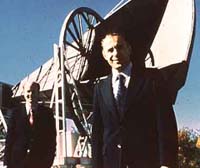
Arno Penzias and Robert Wilson, in front of their microwave antenna at Bell Labs. They won a Nobel Prize for the discovery of the microwave background (photo courtesy of Lucent Technologies, Inc.)
All that changed in the mid-1960s when two radio astronomers from Bell Labs observed a persistent background radio noise from all directions in the sky, which they could not explain. They soon learned that cosmologists (See Catch a Cosmic Microwave) had predicted just this kind of noise as a remnant of the Big Bang fireball, hypothesized to be the beginning of the universe. Subsequent investigations over a wide range of frequencies confirmed this interpretation and firmly established the Big Bang theory as a model well-supported by experiment.
But a serious problem remained, for the observed background appeared to be uniform in all directions. Since the background is the relic of the fireball radiation, then that would have been uniform too, and this uniformity would have prevented matter from clumping together through gravitation to form stars and galaxies. Theorists became uneasy, since they had expected that the increasing precision of these measurements would reveal irregularities in the background between neighboring patches of sky.
More sensitive detectors, placed on artificial satellites, came to the rescue. In 1992 the Cosmic Background Explorer (COBE) satellite began taking data from space, above most of the disturbances of the atmosphere, and revealed the long-awaited granularity in the microwave background, as shown in the image. The results enabled cosmologists to explain the observed distribution of matter in the universe using the concept of “inflation,” the extreme expansion of space immediately after the Big Bang explosion.
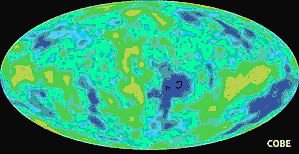
The microwave sky as imaged by COBE. The variations in color correspond to temperature differences in the microwave background between neighboring patches of sky. (image courtesy of NASA).
Research
After COBE, experimental cosmologists planned new and more precise measurements. The successor to COBE is the Microwave Anisotropy Project, now called the Wilkinson Microwave Anisotropy Project (WMAP) in honor of David Wilkinson, a leader on both COBE and MAP, who died in 2002.
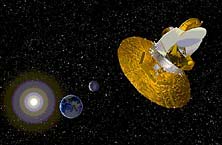
WMAP on its way to its orbit around the Lagrange point L2. From this orbit, the WMAP detector points outward approximately along the line between the sun and Earth. Note the circular baffle that prevents light from the sun from reaching the detector. (image courtesy of NASA/ WMAP science team)
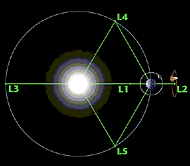
The Lagrange points, with WMAP in orbit about L2. (image courtesy of NASA/WMAP science team)
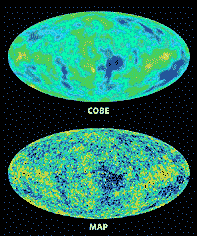
A comparison in the imaging of the microwave background by COBE and WMAP. (image courtesy of NASA)
Unlike COBE, whose orbit was a few hundred miles high, WMAP occupies an orbit about 1.5 million kilometers from Earth around the Lagrange point “L2,” as shown in the drawings. At Lagrange points, the combined effect of the gravity of the Earth and the sun enable a spacecraft to assume a stable orbit around a point in empty space. WMAP’s detector always points away from the sun and sweeps across the whole sky in one year. Note that the design of the probe includes a large circular shield to prevent sunlight from reaching the detector.
WMAP improved the temperature sensitivity by a factor of a thousand and the angular resolution—the fineness of detail—by a factor of 30. For comparison, two images, one above the other, show the whole-sky measurements for the microwave background for COBE and WMAP.
Key implications of the WMAP measurements include these:
- A more accurate age of the universe, 13.7 billion years, plus or minus .2 billion years
- A more accurate date for the beginning of star formation—only 200 million years after the Big Bang, three times sooner than previously thought.
- Evidence that the universe will expand forever
- More evidence for the inflation model
With WMAP, cosmology has achieved the status of “precision science,” a great advance for a field that wasn’t taken very seriously only fifty years ago. And cosmologists are already planning the next generation of microwave background probes.
Links
NASA










